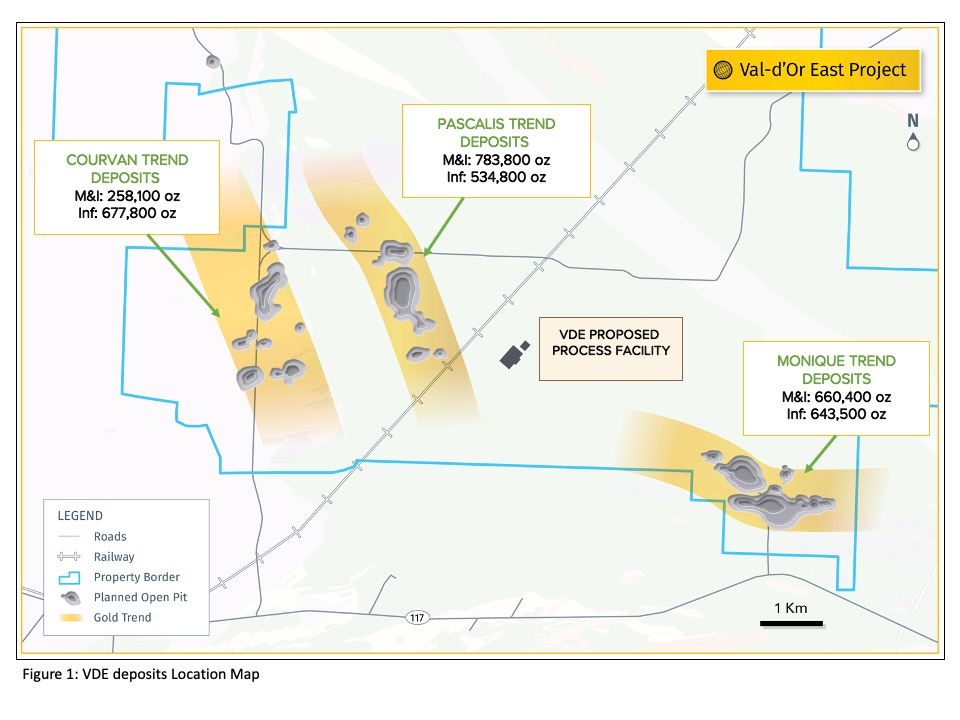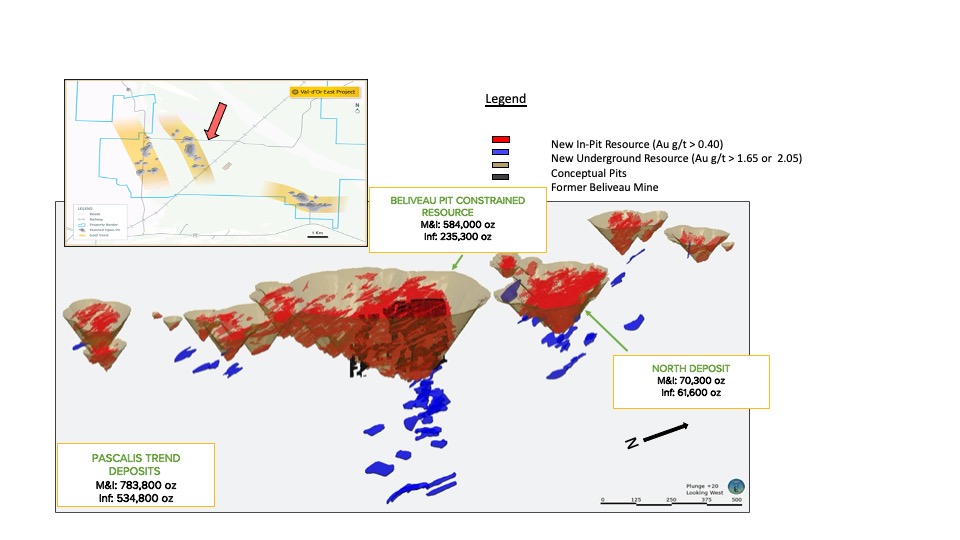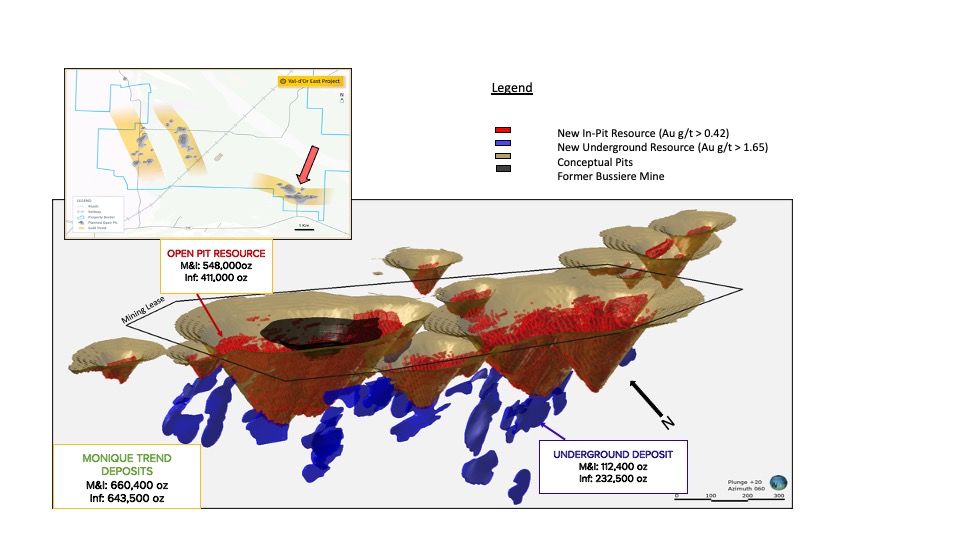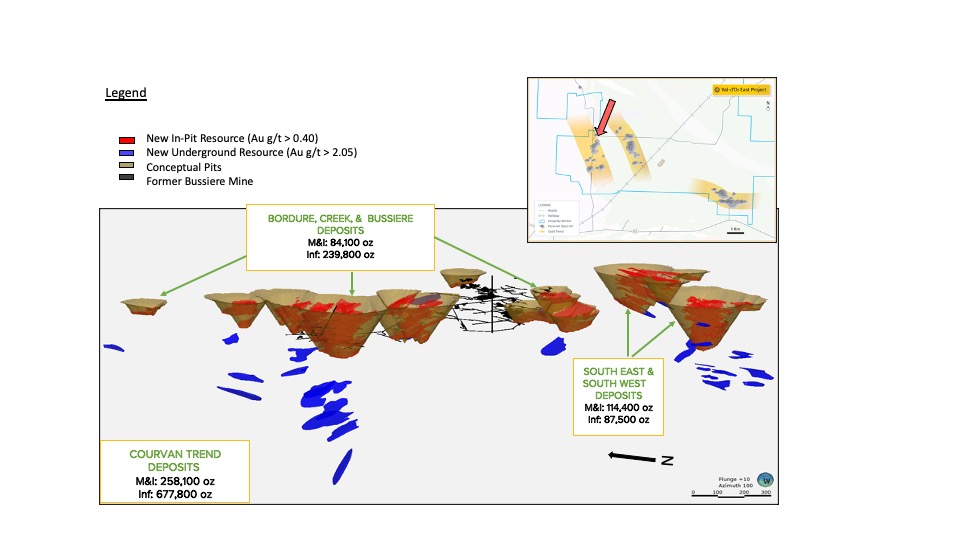This website uses cookies so that we can provide you with the best user experience possible. Cookie information is stored in your browser and performs functions such as recognising you when you return to our website and helping our team to understand which sections of the website you find most interesting and useful.
Probe Gold News
Probe Metals Increases Gold Resource to 1,773,500 Ounces Measured & Indicated and 2,205,300 Inferred at the Val-d’Or East Project, Doubles Amount of Measured and Indicated Resource
Highlights:
- The resource estimate demonstrates significant increase in Measured & Indicated (“M&I”) ounces, continued expansion of the gold resource and potential future resource upside
- 16% increase in total ounces, 2.68M ounces in pit constrained resource and 1.30M ounces in underground resource
- 105% increase in overall M&I ounces
- Monique deposit is a standout performer, more than doubling its current resource to 660,400 M&I and 643,500 Inferred with over 90% within the current mining lease
- Monique and Pascalis gold deposits will form the cornerstone of the upcoming Preliminary Economic Assessment (“PEA”), representing 77% of the pit-constrained Mineral Resource Estimate
- This new resource will form the basis of the PEA expected in Q3-2021
- Drilling continues at the Val-d’Or East Project, with 50,000 metres of additional drilling in 2021
Toronto, June 1st, 2021 – Probe Metals Inc. (TSX-V: PRB)(OTCQB: PROBF) (“Probe” or the “Company”) is pleased to announce the release of an Updated Resource Estimate for its Val-d’Or East project (the “Project”) located near Val-d’Or, Quebec. The estimate includes resources from the Company’s 100%-owned Pascalis, Monique and Courvan properties as well as its option property, Cadillac Break East. With the discovery and the expansion of the gold zones, the mineral resources have shown significant improvement over the previous resource estimate and remain open for future expansion. The current resource stands at 1,773,500 ounces of gold in the Measured & Indicated category (“M&I”) and 2,205,300 ounces of gold in the Inferred category. Drilling was successful in converting an additional 907,200 ounces to the M&I category from the previous resource estimate. This resource estimate was independently prepared by GoldMinds Geoservices Inc. in accordance with National Instrument 43-101 (“NI 43-101”) and is June 1, 2021. Drills will be active throughout 2021 on further expansion, infill drilling and regional exploration.
David Palmer, President and CEO of Probe, states, “This new resource marks the graduation of Val-d’Or East from an exploration project to a potential mining project with tremendous upside for additional growth. The resource shows a significant improvement from previous estimates not only in size but also in the quality of its ounces. The amount of measured and indicated resource, a project’s best gauge of mineability, has more than doubled, while overall grade has also increased substantially. Monique has been the standout performer this year, showing excellent advances in both resource size and quality with almost all of the ounces identified on the mining lease, while Courvan and Pascalis have seen improvement in quality and grade. This current resource estimate will not only form an excellent base for our upcoming PEA, but will also guide us towards future exploration as we continue to grow and advance this project”.
Yves Dessureault, COO of Probe, states, “Our goal for this resource was to highlight Val-d’Or East’s potential as a development project and we have been extremely successful in demonstrating this. We have increased the size, grade and confidence of our total resource and our M&I ounces have now reached a critical mass that could support a robust mining operation. We have worked with GoldMinds and Ausenco to incorporate as much mining engineering concepts into our updated resource estimate and thus maximize the conversion of this resource estimate into mineable resources that will be part of the upcoming PEA integrated mine plan. We are now able to conceptualize an economically viable scale of mine throughput and mine life, and have identified a number of project opportunities, such as ore sorting, which could add significant value to an operation by capturing marginal ore that otherwise would be lost to the waste piles. Val-d’Or East is located in one of the most well-established, mining-friendly jurisdictions in the world and with these results we are eager to advance our project through economic studies”.
Val-d’Or East Project – Summary of Mineral Resources
The Val-d’Or East Project includes the properties on the Pascalis Gold Trend, the Monique Gold Trend and the Courvan Gold Trend, which are 100% owned by Probe.
Table 1: Val-d’Or East Property (100% interest)

As part of its land consolidation strategy for the Val-d’Or East project, Probe earned a 60% interest in the Cadillac Break East Property in joint venture with O3 Mining Inc., which includes the Sleepy deposit. The Company also owns a 100%-interest in the Val-d’Or East Lapaska and Senore properties.
Table 2: Val-d’Or East Other Properties

1 NI 43-101 Technical Report Val-d’Or East Project – October 2019, 100% interest
2 NI 43-101 Technical Report Sleepy Project – December 2014, Option to earn 60%, 60% presented
The Company has demonstrated with a series of performance tests that the ore sorting technology works very well with the type of mineralization found on the Val-d’Or East project. By applying ore sorting to mineralized waste with very conservative gold recoveries additional mineral material may be extracted from the mineralized waste and thus become additional mineral resource on the Project.
Table 3: Val-d’Or East Project – Additional Pit Constrained Resource from Ore Sorting
| Resources Category | Tonnes | Grade (Au g/t) | Ounces (oz.) |
| Measured | 996,000 | 0.32 | 10,300 |
| Indicated | 5,799,000 | 0.33 | 60,900 |
| Measured & Indicated | 6,795,000 | 0.33 | 71,200 |
| Inferred | 7,438,000 | 0.31 | 75,300 |
Notes:
- This additional pit-constrained Mineral Resource represents low grade material between a cut-off of 0.25g/t and the cut-off grade of 0.40 or 0.42g/t Au of the pit-constrained Mineral Resource from Table 1. This lower cut-off was based on the following parameters: ore sorting cost $2.00/t, Gold recovery in the ore sorting process 75% with an overall gold recovery with gravity and leaching at 68%, mass recovery in the ore sorting process 40%.
The following table presents the detailed gold resources for each of the trends/deposits that comprise the Val-d’Or East Project:
Table 4: Val-d’Or East Project – Detailed Resources

Notes:
- Mineral resources which are not mineral reserves do not have demonstrated economic viability. The estimate of mineral resources may be materially affected by environmental, permitting, legal, title, market or other relevant issues. The quantity and grade of reported inferred Resources are uncertain in nature and there has not been sufficient work to define these inferred resources as indicated or measured resources.
- The database used for this mineral estimate includes drill results obtained from historical to the recent 2020 drill program.
- The pit-constrained updated Mineral Resources are reported at a cut-off grade of 0.42g/t Au for the Monique deposit and 0.40g/t for the other deposits. These cut-offs were calculated at a gold price of US$1,600 with an exchange rate of 1.333 US$/C$ per troy ounce. They were based on the following parameters: mining cost 3.00 or 3.50$/t, processing + G&A costs $21.50/t, transport cost to the central processing facility based on distance on existing roads @ $0.15/t.km, Au recovery 95%, pit slopes from 48° to 59° as per the press release of February 23rd, 2021.
- The underground Mineral Resources were based on two main mining methods, long-hole retreat at $82/t depending on width of stopes, and mechanized cut & fill at $110/t and the same above ground unit cost as for the pit-constrained scenario, resulting in cut-off grades of 1.65 and 2.05 g/t Au. These cut-off grades were then used to delineate continuous underground mineral shapes above the calculated cut-off grades. Blocks within those UG mineral shapes that are below the cut-off were included as dilution material and the grade reported represents the average of all UG mineral shapes thus delineated.
- The geological interpretation of the deposits was based on lithologies and the observation that mineralized domains occur either within or proximal to sub-vertical dykes, deformation zones or as low dipping quartz tourmaline vein sets.
- The mineral resource presented here were estimated with a block size of 5m X 5m X 5m for the Monique pit-constrained Mineral Resource and a block size of 2.5m X 2.5m X 2.5m for all others.
- The blocks were interpolated from equal length composites calculated from the mineralized intervals. Prior to compositing, high-grade gold assays were capped (capping maximum ranges from 28 to 100 g/t Au depending on the deposit). Depending on the deposit, the composites were 1.0 metre or 1.5 metres.
- The mineral estimation was completed using the inverse distance to the square methodology utilizing three passes. For each pass, search ellipsoids followed the geological interpretation trends were used.
- The Mineral Resources have been classified under the guidelines of the CIM Standards on Mineral Resources and Reserves, Definitions and Guidelines prepared by the CIM Standing Committee on Reserve Definitions and adopted by CIM Council (2019), and procedures for classifying the reported Mineral Resources were undertaken within the context of the Canadian Securities Administrators NI 43-101.
- In order to accurately estimate the resources, underground voids (shaft, ramp and drifts) and the existing pits were subtracted from the mineralized bodies modeled prior to the pit optimization.
- Tonnage estimates are based on measured rock densities by Gold Trend. 2.82 tonnes per cubic metre for the Courvan Gold Trend, 2.83 for the Pascalis Gold Trend and 2.88 for the Monique Gold Trend. Results are presented undiluted and in situ for the pit-constrained resources and diluted for the UG resources.
- This mineral resource estimate is dated June 1, 2021 and the cut-off date for the drillhole database used to produce this updated mineral resource estimate is May 8, 2021. Tonnages and ounces in the tables are rounded to nearest thousand and hundred respectively. Numbers may not total due to rounding.
- Additional details will be provided in the technical report.
Additions to the Current Resource Estimate Relative to the 2019 Resource Estimate
The 2019 mineral resource estimate hosted a NI 43-101 resource of 0.87M ounces of gold Measured & Indicated and 2.56M ounces of gold Inferred. A total of 74,662 metres has been drilled since this Resource Estimate. Using a gold price of USD $1,600 per ounce, the updated NI 43-101 mineral resource hosts 1.77M ounces of gold measured and indicated, and 2.21M ounces gold inferred, net to Probe, representing an increase of 16% in total size and an increase of 105% in the M&I category. A total of 84% of the new, 2021, M&I resources are pit-constrained.
To view the VDE deposits location map, deposits 3D views, please follow the links below:
Figure 1: VDE deposits Location Map

Figure 2: Block Model 3D view – Pascalis Gold Trend Area

Figure 3: Block Model 3D view – Monique Gold Trend Area

Figure 4: Block Model 3D view – Courvan Gold Trend Area

The following sensitivity table presents the current resource estimate at different cut-offs.
Table 5: Val-d’Or East Project – Pit Constrained Resource Sensitivity by Cut-Off Grades
| Resources Category | Cut-Off Grade | Tonnes | Grade(Au g/t) | Ounces (oz.) |
| Pit-Constrained Resources | ||||
| Measured | 0.60 | 4,169,000 | 2.48 | 332,700 |
| 0.50 | 4,589,000 | 2.31 | 340,100 | |
| 0.40 | 5,111,000 | 2.12 | 347,600 | |
| 0.30 | 5,740,000 | 1.92 | 354,600 | |
| 0.25 | 6,107,000 | 1.82 | 357,900 | |
| Indicated | 0.60 | 16,596,000 | 1.87 | 995,300 |
| 0.50 | 18,938,000 | 1.70 | 1,036,600 | |
| 0.40 | 21,404,000 | 1.56 | 1,072,700 | |
| 0.30 | 25,218,000 | 1.38 | 1,116,100 | |
| 0.25 | 27,203,000 | 1.30 | 1,133,600 | |
| Inferred | 0.60 | 16,700,000 | 1.91 | 1,028,100 |
| 0.50 | 19,194,000 | 1.74 | 1,072,100 | |
| 0.40 | 21,873,000 | 1.58 | 1,111,000 | |
| 0.30 | 26,407,000 | 1.37 | 1,162,300 | |
| 0.25 | 29,527,000 | 1.25 | 1,188,500 | |
Notes:
- Tonnages and ounces in the tables are rounded to nearest thousand and hundred respectively.
- The above table includes the deposits in the Pascalis Gold Trend, the Monique Gold Trend, the Courvan Gold Trend, Lapaska and Senore. Since the cut-off grades are sometimes difference for these deposits (0.40g/t for Courvan and Pascalis, 0.42g/t for Monique and 0.50g/t for Lapaska and Senore), the totals cannot be directly correlated with the data in Tables 1 to 3.
Resource Estimation Methodology and Parameters
As part of the resource estimation process, the Company and GoldMinds compiled, verified and modelled all technical information available from the Project, including 3,005 drill hole collars consisting of 319,729 gold assays, which represented 643,439.94 metres of drilling. 3D geological models were built for sub-vertical structures and shallow dipping veins and included key structures hosting and constraining gold mineralization along the Pascalis Gold Trend (New Beliveau, North Zone and Highway deposits), the Monique Gold Trend and Courvan Gold Trend (Southwest, Southeast, Bordure, Bussiere and Creek deposits).
Next Steps
A technical report with respect to the latest mineral resource estimate disclosed today will be filed within 45 days in accordance with NI 43-101. The resource estimate will be the basis for the ongoing PEA to be released in Q3-2021.
About the Val-d’Or East Project
Since 2016, Probe Metals has been consolidating its land position in the highly prospective Val-d’Or East area in the province of Quebec. The Val-d’Or East project is a district-scale land package comprising 436 square kilometers and represents one of the largest land holdings in the Val-d’Or mining camp. The property is host to three past producing mines (Beliveau Mine, Monique Mine and Bussiere Mine) and falls along four regional mine trends, including 14 kilometres of strike length along the prolific Cadillac Break. Val-d’Or East is situated in a politically stable and low-cost mining environment that hosts numerous active producers and mills.
Independent Qualified Persons
The Mineral Resource prepared for Probe Metals Inc. under the supervision of GoldMinds Geoservices Inc. (“GMG”). The Qualified Persons (“QPs”) have reviewed and approved the content of this news release. Independent QPs from GMG who have prepared and supervised the preparation of the technical information relating to this Mineral resource estimates:
- Merouane Rachidi, Ph.D. P.Geo.
- Claude Duplessis, Eng.
The technical content of this press release has been reviewed and approved by Mr. Marco Gagnon, P.Geo., Executive Vice President of Probe Metals Inc.
Quality Control
During the 2019 and 2020 drilling program, assay samples were taken from the NQ core and sawed in half, with one-half sent to Activation Laboratories Ltd. or AGAT Laboratories Ltd. and the other half retained for future reference. A strict QA/QC program was applied to all samples; which includes insertion of mineralized standards and blank samples for each batch of 20 samples. The gold analyses were completed by fire-assayed with an atomic absorption finish on 50 grams of materials. Repeats were carried out by fire-assay followed by gravimetric testing on each sample containing 3.0 g/t gold or more. Total gold analyses (Metallic Sieve) were carried out on the samples which presented a great variation of their gold contents or the presence of visible gold. Historical drilling program assay sampling procedures are disclosed in the NI 43-101 technical report: Mineral Resource Val-d’Or East Property – October 18, 2019.
About Probe Metals:
Probe Metals Inc. is a leading Canadian gold exploration company focused on the acquisition, exploration and development of highly prospective gold properties. The Company is committed to discovering and developing high-quality gold projects, including its key asset the Val-d’Or East Gold Project, Quebec. The Company is well-funded and controls a strategic land package of approximately 1,550-square-kilometres of exploration ground within some of the most prolific gold belts in Quebec. The Company was formed as a result of the sale of Probe Mines Limited to Goldcorp Inc. in March 2015. Newmont Corporation currently owns approximately 11.6% of the Company.
On behalf of Probe Metals Inc.,
Dr. David Palmer,
President & Chief Executive Officer
For further information:
Please visit our website at www.probemetals.com or contact:
Seema Sindwani
Director of Investor Relations
+1.416.777.9467
Forward-Looking Statements
Neither TSX Venture Exchange nor its Regulation Services Provider (as that term is defined in the policies of the TSX Venture Exchange) accepts responsibility for the adequacy or accuracy of this release. This News Release includes certain “forward-looking statements” which are not comprised of historical facts. Forward-looking statements include estimates and statements that describe the Company’s future plans, objectives or goals, including words to the effect that the Company or management expects a stated condition or result to occur. Forward-looking statements may be identified by such terms as “believes”, “anticipates”, “expects”, “estimates”, “may”, “could”, “would”, “will”, or “plan”. Since forward-looking statements are based on assumptions and address future events and conditions, by their very nature they involve inherent risks and uncertainties. Although these statements are based on information currently available to the Company, the Company provides no assurance that actual results will meet management’s expectations. Risks, uncertainties and other factors involved with forward-looking information could cause actual events, results, performance, prospects and opportunities to differ materially from those expressed or implied by such forward-looking information. Forward looking information in this news release includes, but is not limited to, the Company’s objectives, goals or future plans, statements, exploration results, potential mineralization, the estimation of mineral resources, exploration and mine development plans, timing of the commencement of operations and estimates of market conditions. Factors that could cause actual results to differ materially from such forward-looking information include, but are not limited to failure to identify mineral resources, failure to convert estimated mineral resources to reserves, the inability to complete a feasibility study which recommends a production decision, the preliminary nature of metallurgical test results, delays in obtaining or failures to obtain required governmental, environmental or other project approvals, political risks, inability to fulfill the duty to accommodate First Nations and other indigenous peoples, uncertainties relating to the availability and costs of financing needed in the future, changes in equity markets, inflation, changes in exchange rates, fluctuations in commodity prices, delays in the development of projects, capital and operating costs varying significantly from estimates and the other risks involved in the mineral exploration and development industry, an inability to predict and counteract the effects of COVID-19 on the business of the Company, including but not limited to the effects of COVID-19 on the price of commodities, capital market conditions, restriction on labour and international travel and supply chains, and those risks set out in the Company’s public documents filed on SEDAR. Although the Company believes that the assumptions and factors used in preparing the forward-looking information in this news release are reasonable, undue reliance should not be placed on such information, which only applies as of the date of this news release, and no assurance can be given that such events will occur in the disclosed time frames or at all. The Company disclaims any intention or obligation to update or revise any forward-looking information, whether as a result of new information, future events or otherwise, other than as required by law.
